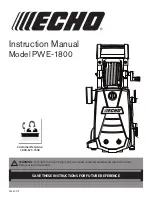
16
17
top side of the cover counterclockwise until the pin is free of
the cup portion. Lift the pin out of the cover and remove the
cup from under the cover. Carefully pull the small gasket off
the threaded shaft on the cup portion. Wash all parts in warm,
sudsy water. Use a soft cloth or small nylon brush to clean
the cover hole.
4. To reassemble the air vent cover lock, place the small gasket
over the threaded shaft of the cup portion. Reinsert the cup
portion by pushing the threaded shaft through the air vent/
cover lock opening from the underside of the cover (Fig. M).
Screw the pin portion clockwise onto the threaded shaft until
it is not possible to tighten it any further.
5. The overpressure plug can be removed for cleaning by pushing
it out of its opening from the top of the cover. After cleaning,
reinsert the plug by pushing the domed side of the plug into
the opening from the underside of the cover, until the bottom
edge is fully and evenly seated against the underside of the
cover. When the overpressure plug is properly installed, the
word (TOP) will be visible on the overpressure plug when
viewing the outside of the cover (Fig. N).
If the overpressure plug is ever forced out of its cover open-
ing due to excess pressure while cooking or canning, it is
important to call the Test Kitchen at 1-800-368-2194.
Do not
attempt to use the released overpressure plug .
6. Pouring water into a dry overheated canner may crack the
metal.
7. Do not strike the rim of the canner body with any cooking
utensil as this will cause nicks which may damage the rim
and allow steam to escape.
8. When your pressure canner is not in use, invert the cover on the
canner body and store in a dry place. Storing the canner with
the cover locked on may cause unpleasant odors and deform
the sealing ring.
9.
To ensure safe operation and satisfactory performance,
replace the overpressure plug every time you replace the
sealing ring or sooner if it becomes hard, deformed, cracked,
worn, or pitted. Replace the sealing ring and overpressure plug
at least every three years. Failure to follow these instructions
could result in bodily injury or property damage.
10. If the canner body or cover handles become loose, tighten
them with a screwdriver.
11. If leakage of moisture or steam develops while using your
canner, check the following possible causes:
The formation of a small amount of moisture under the
pressure regulator is normal when canning or cooking first
begins. This condensation is a result of the temperature of
the pressure regulator being lower than the rest of the can-
ner. If excess condensation continues, the vent pipe may be
loose and should be tightened with an adjustable wrench.
Leakage between the cover and body is usually caused by
shrinkage of the sealing ring after prolonged use. Replace
the sealing ring and overpressure plug.
A slight amount of leakage around the air vent/cover lock
is normal when canning or cooking first begins. If leakage
continues, the cover handles may not be fully aligned with
the body handles and, therefore, the cover lock cannot
engage (see page 11, step 6). Clean the air vent/cover lock
occasionally to assure that it operates correctly (see page
15, step 3). Replace the small gasket if cracked or nicked.
A small amount of steam or moisture may be visible around
the overpressure plug when canning or cooking begins.
This will stop when the overpressure plug seals. If leak-
age continues, clean or replace the overpressure plug (see
page 16, step 5).
Overpressure Plug
Indented Portion
Cover
Top
Fig . N











































